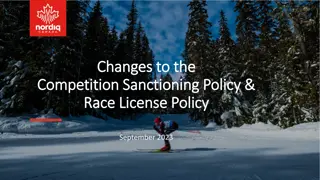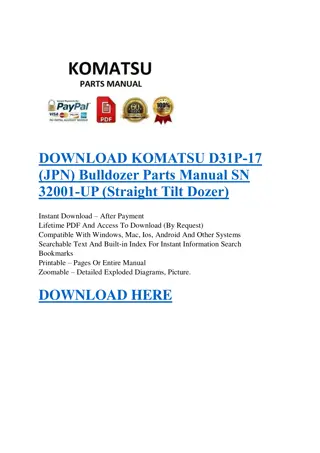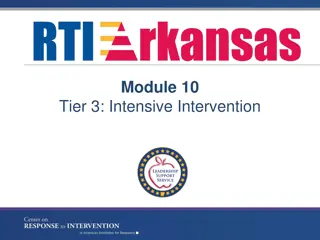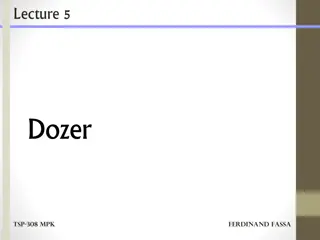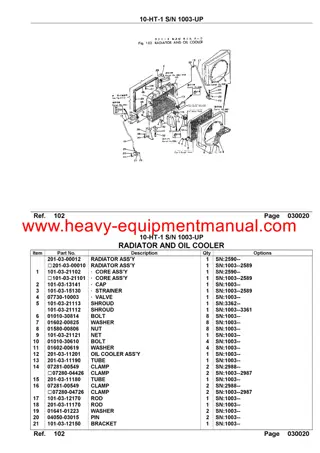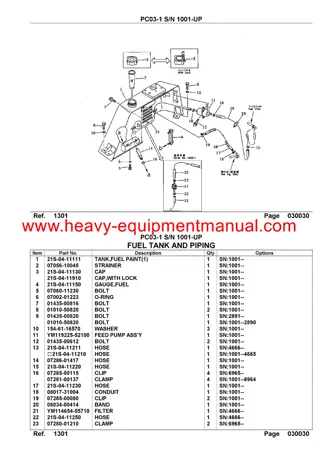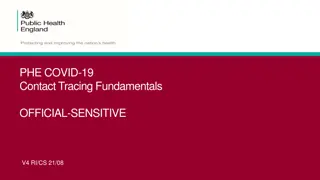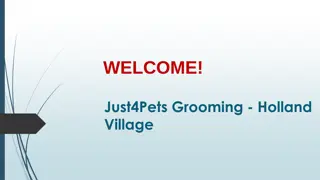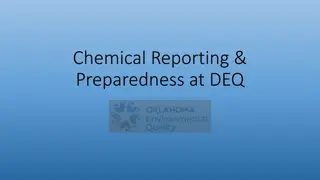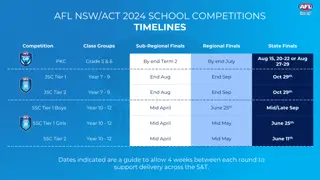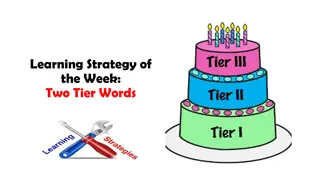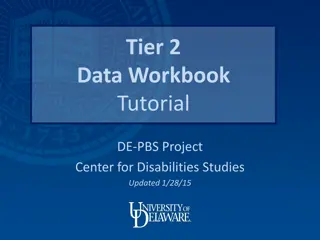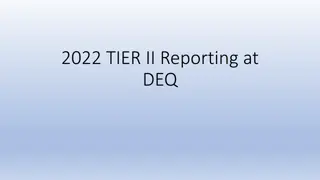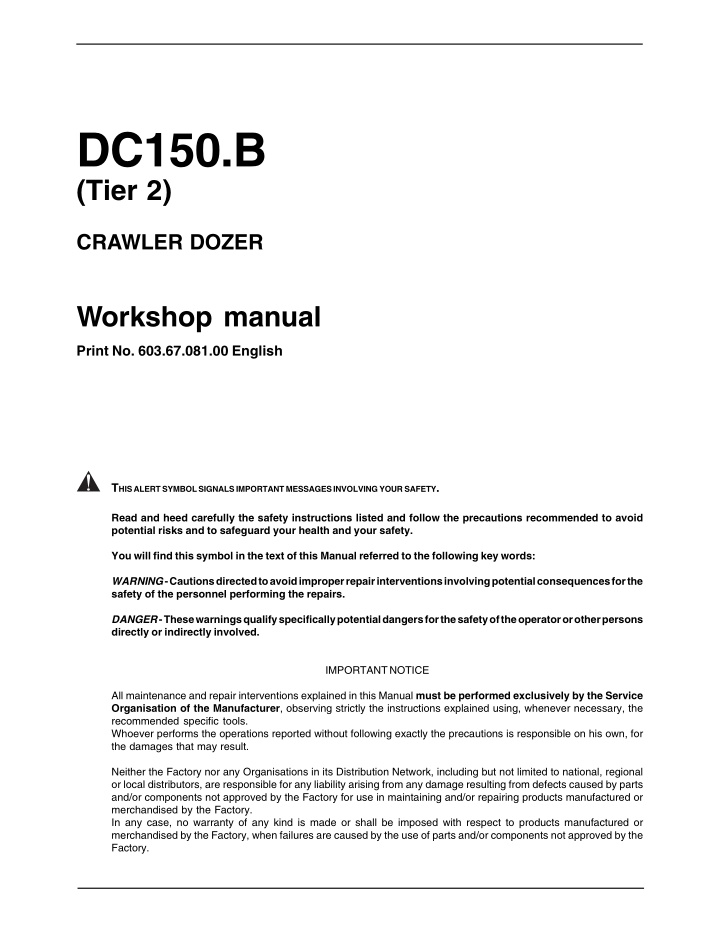
New Holland DC150B Tier 2 Crawler Dozer Service Repair Manual Instant Download
New Holland DC150B Tier 2 Crawler Dozer Service Repair Manual Instant Download
Download Presentation

Please find below an Image/Link to download the presentation.
The content on the website is provided AS IS for your information and personal use only. It may not be sold, licensed, or shared on other websites without obtaining consent from the author. If you encounter any issues during the download, it is possible that the publisher has removed the file from their server.
You are allowed to download the files provided on this website for personal or commercial use, subject to the condition that they are used lawfully. All files are the property of their respective owners.
The content on the website is provided AS IS for your information and personal use only. It may not be sold, licensed, or shared on other websites without obtaining consent from the author.
E N D
Presentation Transcript
DC150.B (Tier 2) CRAWLER DOZER Workshop manual Print No. 603.67.081.00 English THISALERTSYMBOLSIGNALSIMPORTANTMESSAGESINVOLVINGYOURSAFETY. Read and heed carefully the safety instructions listed and follow the precautions recommended to avoid potential risks and to safeguard your health and your safety. You will find this symbol in the text of this Manual referred to the following key words: WARNING - Cautions directed to avoid improper repair interventions involving potential consequences for the safety of the personnel performing the repairs. DANGER - These warnings qualify specifically potential dangers for the safety of the operator or other persons directly or indirectly involved. IMPORTANT NOTICE All maintenance and repair interventions explained in this Manual must be performed exclusively by the Service Organisation of the Manufacturer, observing strictly the instructions explained using, whenever necessary, the recommended specific tools. Whoever performs the operations reported without following exactly the precautions is responsible on his own, for the damages that may result. Neither the Factory nor any Organisations in its Distribution Network, including but not limited to national, regional or local distributors, are responsible for any liability arising from any damage resulting from defects caused by parts and/or components not approved by the Factory for use in maintaining and/or repairing products manufactured or merchandised by the Factory. In any case, no warranty of any kind is made or shall be imposed with respect to products manufactured or merchandised by the Factory, when failures are caused by the use of parts and/or components not approved by the Factory.
AVOID ACCIDENTS Most accidents, whether they occur in industry, on the farm, at home or on the road, are caused by the failure of some individuals to follow simple and fundamental safety rules and precautions. For this reason MOST ACCIDENTS CAN BE PREVENTED by recognising the real cause and doing something aboiut it before the accident occurs. Regardless of the care used in the design and construction of any type of equipment, there are many conditions that cannot be completely safeguarded against without interfering in the reasonable accessibility and efficient operation. A carefull operator is the best insurance against an accident. The complete observance of one simple rule would prevent many serious accidents. The rule is simple: never attempt to clean, lubricate or maintain a machine while it is in motion. WARNING Prior to engaging in any maintenance, adjustment or repair operation on machines having hydraulically, mechanically, and/or cable controlled equipment (such as shovels, loaders, dozers, excavators etc.) be certain the equipment is lowered to the ground. If it is necessary to have the equipment partially or fully raised to gain access to certain items, be sure the equipment is suitably supported by means other than the devices used for controlling the equipment.
SUMMARY GENERALITIES SECT. 0 ENGINE SECT. 1 TRANSMISSION SECT. 2 FINAL DRIVES SECT. 3 BRAKES AND STEERING DIFFERENTIAL SECT. 4 UNDERCARRIAGE SECT. 5 DOZER EQUIPMENT HYDRAULIC SYSTEM SECT. 6 ELECTRICAL SYSTEM SECT. 7 7 1 6 4 5 2 3 D150-2M079
https://www.ebooklibonline.com Hello dear friend! Thank you very much for reading. Enter the link into your browser. The full manual is available for immediate download. https://www.ebooklibonline.com
SECTION 0 GENERALITIES TABLE OF CONTENTS SUBJECT PAG. SAFETY RULES .......................................................................................................................................I - VIII IDENTIFICATION DATA................................................................................................................................. 0-1 TABLE OF FLUID CAPACITIES .................................................................................................................... 0-2 TABLE OF CENTRE OF GRAVITY ............................................................................................................... 0-3 MAIN DIMENSIONS AND WEIGHTS............................................................................................................ 0-4 TABLES OF TECHNICAL DATA..................................................................................................................... 0-8 CHECK DATA ON THE MACHINE ................................................................................................................0-19 EQUIPMENT MANOEUVRE TIMES ............................................................................................................0-20 LEAKAGES .................................................................................................................................................0-21 GENERAL INSTRUCTIONS.........................................................................................................................0-22 DIAGNOSTIC CHECKS ...............................................................................................................................0-28 UNITS OF MEASURE .................................................................................................................................0-29 TABLE OF TIGHTENING TORQUES............................................................................................................0-31
SAFETY RULES WARNING Study carefully this Manual before starting, operating, maintaining, fuelling or servicing the machine. Read and heed all safety rules before any intervention. SAFETY RULES - Check brakes, steering and attachment controls before moving. Advise the proper maintenance authority of anymalfunctioning part or system. - Do not allow unauthorised personnel to operate service or maintain this machine. - Do not wear rings, wrist watches, jewellery, loose or hanging apparels, such as ties, torn clothing, scarves, unbuttoned or unzipped jackets that can catch on mov- ing parts. Wear proper safety equipment as recommend- ed for the job. Examples: hard hat, heavy gloves, ear protection, safety glasses or goggles, reflector vests, respirator. Consult your employer for specific safety equipment requirements. - Be sure all protective guards or panels are in place, and all safety devices provided are in place and in good operating conditions. - Be sure exposed personnel in the area of operation are clear of the machine before moving it or its attachments. WALK COMPLETELY AROUND the machine before mounting. Sound horn. - Keep operator's compartment, stepping points, grab- rails and handles clear of foreign objects, oil, grease, mud or snow accumulation to minimise the danger of slipping or stumbling. Clean mud or grease from shoes before attempting to mount or operate the machine. - Before starting machine, check, adjust and lock the operator's seat for maximum comfort and control of the machine. - Fasten your seat belt (when provided). - Obey all flag signals and signs. - Do not jump on or off the machine. Keep two hands and one foot, or two feet and one hand in contact with step grab rails and handles at all times. - Due to the presence on the machine of flammable fluids, never check or fill fuel reservoirs or batteries near open flames, smoking materials or sparks. - Do not use controls or hoses as hand holds when climbing on or off machine. Hoses and controls are movable and do not provide a solid support. Also, controls may be inadvertently moved causing acciden- tal machine or equipment movement. - REMEMBER THAT STARTING FLUID IS FLAMMA- BLE. Follow strictly the recommendations printed on containers and in the Operation and Maintenance Manual. - DO NOT PUNCTURE OR BURN CONTAINERS. - Never attempt to operate the machine or its tools from any position other than seated in the operator's seat. - Containers must be stored in fresh, well ventilated plac- es, out of reach of unauthorised persons. Follow strictly the instructions provided by the Manufacturer. - Keep head, body, limbs, hands and feet inside opera- tor's compartment at all times, to reduce exposure to hazards outside the operator's compartment. - Never use these products near open flames, smoking materials or sparks. - Be careful of slippery conditions on stepping points, hand rails, and on the ground. Wear safety boots or shoes that have a high slip resistant sole material. OPERATION - Do not leave the machine until it is completely stopped. - Do not run the engine of this machine in closed areas without proper ventilation to remove deadly exhaust gases. - Check the seat safety belt at least twice a year. If there are signs of wear or fraying or other signs of weakness that could lead to failure, replace it. - Roll Over Protective Structures are required on loaders, dozers, graders, excavators. NEVER OPERATE ma- chines without ROPS. STARTING - Make sure the Operator's compartment is free of foreign objects, especially if not firmly secured. Never use the machine to transport objects, unless proper securing points are provided. - NEVER START NOR OPERATE AN UNSAFE MA- CHINE. Before operating a machine, always ensure that any unsafe condition has been satisfactorily remedied. I
SAFETY RULES - Check monitoring instruments at start-up and frequently during operations. in case the brake pressure gauge shows a pressure lower than the minimum operating pressure, stop immediately the machine . - Avoid kinking chains or cables. Do not pull through a kinked chain or cable to the high stresses and possibility of failure of the kinked area. Always wear heavy gloves when handling chains or cables. - DO NOT CARRY RIDERS ON MACHINE - Be sure chains and cables are anchored and the anchor points are strong enough to handle the expected load. Keep exposed personnel clear of anchor points and cables or chains. - Study and familiarise with escape routes alternate to normal exit routes. - Seat belts are required by current regulations to be provided with Roll Over Protection Structures or cabs. Keep safety belts fastened around you during operation. - DO NOT PULL UNLESS OPERATOR's COMPART- MENT OF MACHINES INVOLVED ARE PROPERLY GUARDED AGAINST POTENTIAL CABLE OR CHAIN BACKLASH. - For your personal protection, do not climb on or off machine while machine is in motion. - Be alert to soft ground conditions close to newly con- structed walls. The fill material and weight of the machine may cause the wall collapse under the machine. - Make sure that exposed persons in the area of operation are clear of the machine, before starting the engine and operating the equipment. Sound horn. Obey all indica- tions provided by flags and signals. - In darkness, check area of operation carefully before moving in with machine. Use all lights provided. Do not move into area of restricted visibility. - NEVER COAST the machine down grades and slopes with the transmission in neutral or neutralised. - If engine has a tendency to stall for any reason under load or idle, report this for adjustment to proper mainte- nance authority immediately. Do not continue to operate machine, until condition has been corrected. Choose and shift into the most appropriate gear to keep the speed required, thus preventing any loss of control. - Do not operate machinery in a condition of extreme fatigue or illness. Be especially careful towards the end of working shift. - On machines supplied with suction radiator fans, be sure to periodically check engine exhaust parts for leaks, as exhaust fumes are dangerous to the operator. - Do not operate machine with brakes out of adjust- ment. - In case of closed type cabs, always keep an opening with the outside, to ensure a constant air circulation. - Operate the machine at speeds slow enough to ensure complete control at all times. - Operators must know thoroughly the performances of the machine they are operating. When working on slopes or near sudden level drops of the terrain, avoid areas where ground is loose or soft since rolling-over or loss of control of machine could result. - Travel slowly over rough terrain, on slopes or near drop-offs, in congested areas or on ice or slippery surfaces. - When backing, always look to where the machine is to be moved. Be alert to the position of exposed personnel. DO NOT OPERATE if exposed personnel enter the immediate work area. STOP THE MACHINE. - Where noise exposure exceeds 90 dBA for 8 hours, wear approved ear protection. - Maintain a safe distance from other machines. Provide sufficient clearance for ground and visibility conditions. Yield right-of-way to loaded machines. - When counterweights are provided, do not work ma- chine if they have been removed. - Overtaking manoeuvres must be performed only when absolutely necessary and unavoidable. Beware of pos- sible uneven terrains, poor visibility conditions, the presence of other machinery or persons out of sight. - Maintain clear vision of areas of travel or work. Keep cab windows clean and repaired. - When machines are operating in tandem, the pusher (rear) must be equipped with the appropriate deflectors to protect the unit in front from the air stream coming from the radiator. - Operate the machine at a speed adequate to the working conditions in the site and slow enough to ensure com- plete control at all times. - When pulling or towing through a cable or chain, do not start suddenly at full throttle; take-up slack carefully. - Never use the machine as a work platform or scaffolding, nor other inappropriate operations (i.e. pushing railway cars, trucks or other machines). Inspect carefully for flaws or troubles before using. II
SAFETY RULES - Be alert of people in the operating area of the machine. - NEVER DRIVE OVER THEM or other surface irregular- ities that brake traction with the ground, especially when on slopes or near drop-offs. - When operating a machine, know in advance what clearances will be encountered, overhead doors, ca- bles, pipes, bearing load limitations of ground, bridges, floors or ramps. - Be alert to avoid changes in traction conditions that could cause loss of control. DO NOT DRIVE on ice or frozen ground conditions when working the machine on steep slopes or near drop-offs. - When roading, find-out what conditions are likely to be encountered, clearances, traffic congestion, type of road surfacing, etc. Beware of fog, smoke or dust elements that obscure visibility. - Working in virgin and rough terrains is characterised by the presence of all the perils and risks listed above. In these conditions, it is emphasised the danger represent- ed by large tree limbs (possibly falling on the machine), large roots (acting as a leverage under the machine when up-rooted causing the roll-over of the unit) etc.. - When crossing gullies or ditches, move at an angle with reduced speed after ensuring ground conditions will permit a safe traverse. - Explore the working area to identify potential risks such as: slopes, overhangs, pits, demolition rubble, fires, ravines, ditches, soft terrain, heavy traffic, crowded park- ing areas, closed ambients. In such conditions, proceed with extreme care. STOPPING - When the machine is stopped for whatever reason, follow the instructions of chapters "Stopping the ma- chine" and "Stopping the engine" of the Operation and Maintenance Instruction Manual. - Whenever possible, avoid going over obstacles such as rough terrain, rocks, logs highly irregular ground, steps, ditches, railroad tracks. When obstructions must be crossed, do so with extreme care at an angle, if possible. Reduce speed, shift-down. Ease up to the break over point, pass the balance point slowly on the obstruction and ease down on the other side. - Always remember to position the transmission drive control in neutral and engage the control lock to secure the machine. - The parking brake is automatically set, when the trans- mission safety lever is lowered. - In steep down-hill operation, do not allow engine to over- speed. Select proper gear before starting down grade. - NEVER LEAVE THE MACHINE UNATTENDED with the engine running. - Avoid side hill travel, whenever possible. Drive up and down the slope. Should the machine slipping sideways, turn it immediately downhill. - Always, before leaving the operator's seat and after making sure all people are clear of the machine, slowly lower the attachments or tools flat to the ground in a positive ground support position. - The grade of slope you should attempt will be limited by factors such as condition of the ground, load being han- dled, type of machine, speed of machine and visibility. - Return the controls to rest position. Place the gearshift lever in neutral. Disconnect the master switch and ex- tract the key. - There is no substitute for good judgement when working on slopes. - Park in a non- operating and no-traffic area or as instruct- ed. Park on firm level ground if possible. Where not possible, position machine at a right angle to the slope, making sure there is no danger of uncontrolled sliding movements. - Avoid operating equipment too close to an overhang or high wall, either above or below the machine. Be on the look-out for caving edges, falling objects and slides. Beware of concealment by brush and undergrowth of these danger. - If parking in traffic lanes cannot be avoided, provide appropriate flags, barriers, flares and signals as re- quired. Also provide advance warning signals in the traffic lane of approaching traffic. - When pushing-over trees, the machine must be equipped with proper overhead guarding. Never allow a machine to climb up on the root structure particularly while the tree is being felled. Use extreme care when pushing over any tree with dead branches. - Keep head, body, limbs, feet, fingers or hands away from bucket, blade or ripper when in raised position. - When pushing trees with dead limbs, proceed with extreme care. Avoid brush piles, logs or rocks. - Always disconnect the master switch before any inter- vention (i.e. cleaning, repairing, maintaining, refuel- III
SAFETY RULES ling etc.). Do the same when parking for prolonged periods of time to avoid accidental or unauthorised starting. - Keep operator's compartment, stepping points, grab- rails and handles clear of foreign objects, oil, grease, mud or snow accumulation to minimise the danger of slipping or stumbling. Clean mud or grease from shoes before attempting to mount or operate the machine. - Never lower attachments or tools other than seated in operator's seat. Sound horn. Make sure area near the attachment is clear. Lower the attachment slowly. DO NOT USE FLOAT POSITION of hydraulic system. - Keep shoes free of mud or grease before climbing or driving the machine. - Place master switch in OFF, securely block the machine and lock it every time you leave it unattended. Return keys to authorised security. Heed all shut-down opera- tions of the Operation and Maintenance Instruction Manual are followed. - Never attempt to operate the machine or its tools from any position other than seated in the operator's seat. - When maintenance operations require moving hydrau- lically operated attachments by means of machine's hydraulic system remember that all manoeuvres must be made only when seated in the operator's seat. Before starting machine or moving attachment or tools, set brakes , sound horn and call for an all clear. Raise attachment slowly. MAINTENANCE GENERALITIES - Always block booms or parts of the machine which must be raised to perform interventions under them with external devices. Do not allow persons to move into the vicinities nor standing under equipment not being blocked. Unless you are totally sure about your safety, avoid staying under raised equipment, even in case it is blocked. - Before operating or performing any intervention on the machine: read carefully all the rules contained by this Manual; read and obey all safety related plates and instruc- tions located on the machine. - Do not place the body, limbs or fingers into sharp articu- lation uncontrolled openings of the machine and without proper protections, unless they are blocked in a safe manner. - Do not allow unauthorised personnel to perform any maintenance operation. Do not perform maintenance operation without prior authorisation. Follow all recom- mended maintenance and service procedures. - Never perform interventions with engine running, ex- cept as called for in a Manual. Do not wear loose clothing or jewellery near moving parts. - Keep operator's compartment free of all loose objects that are not properly secured. - Do not wear rings, wrist watches, jewellery, loose or hanging apparels, such as ties, torn clothing, scarves, unbuttoned or unzipped jackets that can catch on mov- ing parts. Wear proper safety equipment as recommend- ed for the job. Examples: hard hat, heavy gloves, ear protection, safety glasses or goggles, reflector vests, respirator. Consult your employer for specific safety equipment requirements. - When servicing or maintenance require access to areas that cannot be reached from the ground, use a ladder or step platform that meet local and national regulations, to reach the service point. If such ladder or platform are not available, use the machine hand holds and steps as provided. Perform all service or maintenance carefully. - Shop and/or field service platforms or ladders must be constructed and maintained in accordance with local and national regulations. - Do not use controls or hoses as hand holds when climbing on or off machine. Hoses and controls are movable and do not provide a solid support. Also, controls may be inadvertently moved causing acciden- tal machine or equipment movement. - Disconnect batteries and tag all controls according to current regulations to warn that work is in progress. Block machine and all attachments that must be raised accord- ing to current regulations. - Do not jump on or off the machine. Keep two hands and one foot, or two feet and one hand in contact with step grab rails and handles at all times. - Due to the presence of flammable fluids, never check or fill fuel tanks, batteries, nor use starting fluid near lighted smoking materials or open flames. - Do not perform any service operation on the machine with a person seated in the operator's compartment, unless he is an authorised operator co-operating in the operation to be performed. - Brakes are inoperative when manually released for servicing. Provisions must be made to maintain control of the machine by blocking or other means. IV
SAFETY RULES - The fuel filling nose must be kept constantly inside the filling neck. Keep this contact from the beginning to the end of the fuelling operation to avoid the possibility that sparks due to static electricity are generated. - Make sure that all mechanic's tools are in good condi- tions. NEVER USE tools with mushroomed heads or frayed. Always wear eye protections. - Move with extreme care when working under the ma- chine, its attachments and or on or near them. Always wear protective safety equipment as required, such as hard hat, goggles, safety shoes, ear plugs. - Use only designated towing or attaching points. Use care in making attachments. Make sure pins and/or locks are secure before pulling. Stay clear of drawbars, cables or chains under load. - When performing operations requiring running of the engine, have a qualified operator in the operator's seat at all times with the mechanic on sight. Place the trans- mission in neutral and set the brakes and safety lock. - To move a disabled machine, use a trailer or a low- boy, if available. In case towing is needed , use all necessary signals required by local and national regulations, and follow the directions provided in this Manual. - KEEP HANDS AND CLOTHING AWAY FROM MOVING PARTS. - To load/unload a machine from transporter, choose a level surface ensuring firm support to the wheels of truck or trailer. Use strong access ramps, with adequate height and angle. Keep surface free of mud, oil or slippery materials. - For field service, move machine to level ground, if possible, and block it. If work on an incline is absolutely necessary, first block machine and its attachments se- curely, than move it to level ground as soon as possible. - Do not trust worn and /or kinked chains and cables: do not use them for lifting or pulling operations. To handle them, always use heavy gloves. - Anchor the machine securely to the bed of truck or trailer and block wheels or tracks with appropriate wedges. - Never align holes with fingers or hands; always use appropriate aligning tools. - Be sure chains and cables are anchored and the anchor points are strong enough to handle the expected load. Keep exposed personnel clear of anchor points and cables or chains. - Eliminate all sharp edges and burrs from re-worked parts. - No bystanders are allowed near the hooking points, chains or cables. - Use only approved grounded auxiliary power sources for heaters, chargers, pumps and similar equipment to reduce the hazards of electrical shocks. - DO NOT PULL UNLESS OPERATOR's COMPART- MENT OF MACHINES INVOLVED ARE PROPERLY GUARDED AGAINST POTENTIAL CABLE OR CHAIN BACKLASH. - Lift and handle heavy parts with a lifting device of proper capacity. Be sure parts are supported by proper slings and hooks. Use lifting eyes if provided. Watch-out for people in the vicinity. - Keep the area where maintenance operations are per- formed CLEAN and DRY. Eliminate immediately all water and oil spillages. - Never pour gasoline or diesel fuel into open, wide and low containers. Never use gasoline, solvent or other flammable fluid to clean parts. Use exclusively qualified, non-flammable, non-toxic commercial solvents. - Do not pile oily or greasy rags; they represent a fire hazard. Store in closed metal container. - When using compressed air for cleaning parts, use safety glasses with side shields or goggles. Limit pres- sure to 2 bar (29 psi), in accordance with local and national regulations. - Before starting machine, check, adjust and lock the operator's seat for maximum comfort and control of the machine. Be sure exposed personnel in the area of operation are clear of the machine before moving it or its attachments. Sound horn. - Do not run the engine in closed areas without proper ventilation to remove deadly exhaust fumes. - Rust inhibitors are volatile and flammable Use only in well ventilated areas. Keep open flames away - DO NOT SMOKE - Store containers in a cool well ventilated place, secure against unauthorised personnel. - Do not smoke or permit any open flames or spark near when re-fuelling or handling flammable materials. - Do not use an open flame as a light source to look for leaks or for inspection anywhere on the machine. - Do not carry loose objects in pockets that might fall unnoticed into open compartments. V
SECTION 1 ENGINE TABLE OF CONTENTS PARAGRAPH SUBJECT PAGE 1.1 1.1.1 1.1.2 GENERAL SPECIFICATIONS OF SERIES B ENGINE ............................................ Engine main specifications .................................................................................... Engine identification............................................................................................... 1-1 1-1 1-2 1.2 DESIGN FEATURES ................................................................................................ 1-3 1.3 SERVICEABILITY .................................................................................................... 1-8 1.4 SECURING THE ENGINE TO THE FRAME .............................................................. 1-9
1 - 1 ENGINE DC150.B For the disassembly, inspection and reassembly of the engine series B5.9 please refer to the Cummins publications that can be procured from the Service organisation The main specifications and data of the engine installed on D150 are listed here below 1.1 GENERAL SPECIFICATIONS OF SERIES B ENGINE 1.1.1 ENGINE MAIN SPECIFICATIONS 6BT AA5.9 Number of cylinders Bore Stroke Total displacement Net flywheel power (DIN 6270) Net flywheel power (SAE J1349) Net flywheel power (ISO 9249) Net flywheel power (EEC 80/1289) Engine weight dry less flywheel and electrical equipment Firing order Idle speed Maximum no-load speed Maximum torque speed Maximum power speed Maximum torque Clearance between valves and rocker arms Intake Exhaust Compression ratio Rotation, seen from front side of engine Air intake 6 102 mm (4 in) 120 mm (4.72 in) 5.9 litres (360 in3) 142 HP/106 kW 140 HP/104 kW 142 HP/105 kW 142 HP/106 kW 432 kg 1-5-3-6-2-4 850 rpm 2460 rpm 1500 rpm 2200 rpm 650 Nm (146 lbf) at 1300 rpm 0.25 mm (0.009 in) 0.50 mm (0.020 in) 17.5:1 clockwise turbocharged w/ aftercooler Lubrication system Lube pressure at low idle Lube pressure at setting speed 0.69 bar (10 psi) 2.07 bar (30 psi) Cooling system Coolant capacity Setting of thermostat Start Maximum opening 9.8 litres (2.6 gal.) 83 C (181 F) 95 C (203 F) Radiator cap pressure with system at 104 C (220 F) 1.03 bar (14.9 psi) Air intake system Maximum allowable restriction on intake at rated speed and load with clogged cartridge 635 mm H2O Exhaust system Maximum allowable restriction on intake at rated speed and load 76.2 mm Hg Carefully read personal and machine SAFETY PRECAUTIONS (at the beginning of this manual)
1 - 2 ENGINE DC150.B 1.1.2 ENGINE IDENTIFICATION Engine data plate The engine data plate includes identification data and other important information relative to the engine. Always have the following engine data available when communicating with a Cummins authorised repair Centre. The information on the data plate are essen- tial when ordering spare parts. To order parts it is necessary to specify Serial number of the engine (E.S.N.) Check list of the parts (CPL) D150-2R0098 Fig. 1-1 Engine are designated as follows: Model nomenclature of industrial engine 6 B T A 5. 9 No. of cylinders Series B Turbocharger Aftercooler Total displacement The first digit indicates the number of cylinders, the letter to follow identifies the series of the engine, the remaining alpha digits indicate the air intake (T = turbo charged) and the last digits indicate the total displace- ment in litres. D150-2R0099 Fig. 1-2 Specifications of engine 6B 5.9 The total displacement of the engine is 5.9 litres (360 in3), the bore is 102 mm (4.01 in) and the stroke is 120 mm (4.72 in). The firing order is the same of all Cummins in-line 6-cylinder: 1-5-3-6-2-4. Total displacement Bore Stroke Firing order litres 5.9 (360 in3) mm 102 (4.01 in) mm 120 (4.72 in) 1-5-3-6-2-4 D150-2R0100 Fig. 1-3 Carefully read personal and machine SAFETY PRECAUTIONS (at the beginning of this manual)
1 - 3 ENGINE DC150.B 1.2 DESIGN FEATURES An automatic belt tensioner is used to provide a cor- rect tension. On series B a variety of mounting posi- tions for fan hubs and belt tensioners usable for auto, industrial and marine applications are available. This front view of the engine illustrates a belt driven fan hub. Belt automatic tensioner Fan hub D150-2R0101 Fig. 1-4 This is the gear train available on Series B engines. All gears are hardened and of an helicoidal teeth type for strength and silent operation. The alignment with reference marks is used between crankshaft gear and camshaft gear. On engines equipped with rotary injec- tion pumps, the timing alignment occurs between the injection pump gear and the camshaft gear. Engines equipped with in-line injection pump do not require a timing between injection pump and camshaft. Camshaft gear with injection pump drive gear Crankshaft gear with camshaft gear D150-2R0102 Fig. 1-5 The cylinder block incorporates several innovative design features. The block casting includes arrange- ments for: - Oil heat exchanger housing. - Water pump intake. - Oil pump housing. - Water pump chamber. - Coolant by-pass duct. Coolant by-pass duct Oil heat exchanger Water pump chamber Water pump inlet Oil pump housing D150-2R0103 Fig. 1-6 Carefully read personal and machine SAFETY PRECAUTIONS (at the beginning of this manual)
1 - 4 ENGINE DC150.B Other design features of the cylinder block casting require: - A block design with a rim for higher strength; - Bored cylinders for pistons with 120 mm (4.72 in) centre to centre distance and 18 mm (0.71 in) cylin- der, so that space is provided to a dry sleeve, if required by service interventions. - Piston cooling. Rimmed block Piston cooling nozzle D150-2R0104 Fig. 1-7 The cylinder head is a single piece designed for a crossed flow with two valves per cylinder. This fea- ture maintains the exhaust energy, cooling slightly, the short exhaust gaps. Crossed flow cylinder head D150-2R0105 Fig. 1-8 An exhaust manifold of a pulsation type coupled to the turbine housing with twin intake is used to im- prove the efficiency of the engine. Twin intake turbine housing Pulsation exhaust manifold D150-2R0106 Fig. 1-9 The design of the cylinder head includes: - Integral intake manifold. - Integral thermostat housing. - Integral fuel filter housing. Intake manifold Fuel filter supports Thermostat housing D150-2R0107 Fig. 1-10 Carefully read personal and machine SAFETY PRECAUTIONS (at the beginning of this manual)
1 - 5 ENGINE DC150.B An additional design feature of the cylinder head in- cludes cast integral valve guides and hardened valve seat surfaces. Service parts and procedures are avail- able for grinding operations and installation for valve guides. Integral valve guide Rocker arm group D150-2R0108 Fig. 1-11 The length of the injection pump requires the reposi- tioning of the fuel filter toward the rear of the engine. This is possible by using a distance filter support. D150-2R0109 Fig. 1-12 The timing is composed of a camshaft, tappets, push rods and rocker arm group. Besides the intake and exhaust valve cams, the camshaft has a special cam to power the fuel pump. Rocker armgroup Fuel pump Push rods Camshaft Tappets D150-2R0110 Fig. 1-13 A single bush of the camshaft, located in the first shaft bore, is used to support the axial thrust of the accessory drives. The remaining journals turn in the camshaft bores in the cast iron block. Service bushes and the procedure to grind and install bushes for all journals of the camshaft are available. Camshaft bush Camshaft journal D150-2R0111 Fig. 1-14 Carefully read personal and machine SAFETY PRECAUTIONS (at the beginning of this manual)
1 - 6 ENGINE DC150.B The power components of the engine are distinguished for special features - Piston. - Conrods. - Crankshaft. Power components Piston Conrod Crankshaft D150-2R0140 Fig. 1-15 The conrod is of an angled split type. This design al- lows having the largest possible big end, to provide strength and long life. The design of the angled split employs a larger surface bearing, thus improving the wear resistance. A piston ceiling oil jet lubricates the bush of the conrod small end. Small end Conrod Large end D150-2R0113 Fig. 1-16 Naturally aspirated engines use aluminium conrod bearings lined, at the rear, by steel, whereas turbo charged engines use tri-metal bearings lined at the back by steel. Service bearings are of the tri-metal type with steel back lining. Conrod bearings Tri-metal with steel back lining Aluminium with steel back lining D150-2R0114 Fig. 1-17 Emissions, applications and power settings determine the type of pistons to be installed on the engine. Simi- lar features of the pistons are a high turbulence top chamber, a free floating pin held by circlips and cast aluminium bodies. D150-2R0115 Fig. 1-18 Carefully read personal and machine SAFETY PRECAUTIONS (at the beginning of this manual)
Suggest: If the above button click is invalid. Please download this document first, and then click the above link to download the complete manual. Thank you so much for reading
1 - 7 ENGINE DC150.B Turbocharged engines use pistons with three ring seats. a single high nickel content insert with a Keystone profile ensures optimised anti-wear features to the upper ring seat. The most powerful turbocharged engines use an anodised lining on the piston face and on the head to increase life. Inserto NIresist Always check the spare part numbers or be sure about the right configuration of the piston to be used as a replacement. Stantuffo turbocompresso D150-2R0116 Fig. 1-19 The crankshaft is an integral steel forged balanced component. Crossed inner drillings provide lubrication to the conrod bearings. The main and conrod journals are significantly larger than competitive engine crankshafts. D150-2R0117 Fig. 1-20 Another technical feature is the use of pressed steel parts to reduce the engine weight. These light components include the timing gear cover, valve cover with breather group and engine sump. D150-2R0118 Fig. 1-21 The design objectives are: - Simplicity. - Reliability. - Durability. - Reduction of components. - Better serviceability. D150-2R0119 Fig. 1-22 Carefully read personal and machine SAFETY PRECAUTIONS (at the beginning of this manual)
https://www.ebooklibonline.com Hello dear friend! Thank you very much for reading. Enter the link into your browser. The full manual is available for immediate download. https://www.ebooklibonline.com

